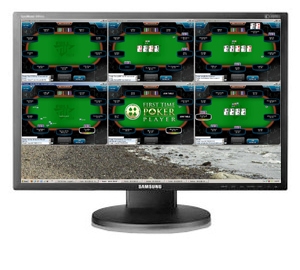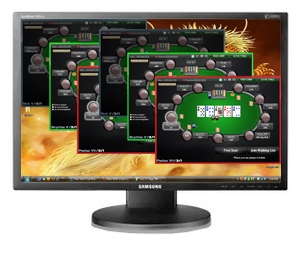Guide To Multi-Tabling in Poker
The biggest difference between online and live poker, and the main reason it can be so much more profitable with far less risk, is the ability to play in more than one game at once. Multi-tabling brings your variance down and your hands per hour up. It allows you to play at much lower limits and yet earn profits equal to that of a much higher live game. And it keeps you from ever getting bored.
But it is also a skill. Don't think just because you know how to play cards that you can jump right into playing six tables at a time. You're going to need to get the right tools in place and practice the specific skills needed to multi-table efficiently before you can play effectively.
Equipment
The correct equipment is key to effective online poker multi-tabling, and that equipment is a big monitor with good resolution. You can multi-table on smaller monitors but it is so much easier to do it when you have ample screen space. I use a Samsung SyncMaster at 1920 x 1200 resolution and can tile six tables easily. A dual monitor set up is even better; I've seen people with dual monitor set ups tiling twelve tables with no overlap.
Tiling or Stacking
When multi-tabling, most poker sites will give you a choice of how they set up the tables for you: Tiling or Stacking. Tiling means every table is fully visible at all times; stacking stacks the tables one on top of each other with just a small location to click on to switch between them. For anything under twelve tables, most people prefer tiling. After that, the tables get so small that it's impossible to tell what's happening. Over twelve and you'll want the tables stacked and let them pop up whenever it's your action - which will be often with so many games running.


Software
You need two kinds of software to multi-table well: tracking software and table management software. Good tracking software (the two biggest are Poker Tracker and Holdem Manager) allows you to quickly see an opponent's proclivities on your screen while you're playing. Quickly, as you'll see in the strategy section, is key. Table management software (Table Ninja is very popular) provides customized hotkeys for common actions as well as automating things like table registration, bet-sizing, time bank management, and a host of other actions.
How Many Tables Should I Play?
As I said before, speed is key in multi-tabling. The more tables you play, the less time you have to make decisions and take actions. Before deciding how many tables to play, you need to know which games lend themselves to multi-tabling. I've ranked them below.
- 1. Sit and Gos: One table tournaments are the most natural fit for multi-tabling. The tight structure and low stack size gets you into no-read/automatic-play mode very early. If you have a good rote strategy you can stack these tables and play a nearly unlimited number at a time. That doesn't mean sit and gos are easy to beat. There are a lot of pros playing a lot of these all the time, and being stuck at several tables with the same group of players is not unusual. A 3% return on your investment is a good result.
- 2. Multi-Table Poker Tournaments: The chance of getting stuck at multiple tables with the same bunch of sharks (see above) is far less in these bigger field tournies. However, there are more read-dependent moves to be made so I prefer to tile these and only play as many as I can see on my screen(s). Your HUD becomes your best friend in these. It's good to play a lot of these early, if you get close or into the money and the decisions become more important, it's good to stop registering for new tournies and concentrate on the ones you've gone deep in.
- 3. Limit Holdem: As a general rule, the less factors you have to calculate, the more tables you can play. With only two cards in your hand and the bet sizes predetermined, limit Holdem lends itself perfectly to multitabling. And playing a bunch of tables can smooth out the variance of this notoriously swingy game.
- 4. No-Limit Holdem: Played with a short-stack (which eliminates a number of choices, making decisions quicker and easier), No-Limit can be a great game to stack a whole bunch of tables. I've seen pros twenty-four table this game and heard of people playing even more. With a bigger stack, I don't go much over six tiled tables as strategy gets more complex as the relative stacks deepen.
- 5. Everything Else: I love alternate games. But the more complex strategies that make them appeal to me also make them much more difficult to multi-table. Adding more hole cards or face cards or introducing split pots just means it takes more time and brain power to figure out each hand. And you don't have either of those to spare when running a bunch of tables. Stick to four or under when playing alternate games, and never play split-pot or low-only in conjunction with high only games. I'll play a table of Stud Hi-Lo and Omaha Eight at the same time, but Stud High and Stud High-Lo together is a recipe for disaster.
The best strategy in multi-tabling is the simplest. If your style of play involves a lot of moves that are dependent on player knowledge and table observation, then multi-tabling isn't for you. You need strategies that work well in a vacuum; strategies that are un-exploitable and optimized for speed. That's why sit and gos are so great: most of them are played in a zone where your only two choices are push or fold and you don't need to think too much about what the other players are holding.
Success in multi-tabling is like anything else: start slow and work your way up. Start with two tables of your best game and see how it goes. Remember, when playing two tables, you can play at half the limit you usually do and still have the same amount of money in play. When just starting, I suggest going with a quarter of your normal limit. When you are beating the game regularly, add another table and see how it goes.
A Natural Limit
In my own experience, and in the experience of those I've talked to, everyone seems to have their own natural limit of tables they can play effectively. And that number lowers as you get older. (Actually older. Twenty-nine year old me could run twelve tables as well as twenty-seven year old me could. Forty-year old me can do six tables max.) You will find a spot where you can no longer follow the action effectively, and no matter how hard you try, it doesn't get any better. Don't bang your head against the wall, just drop back to your sweet spot and start earning again.
Sitemap | About & Contact | Disclaimer | Privacy

PokerSites.com is the only dedicated review site selected as a member of the Interactive Gaming Council.
